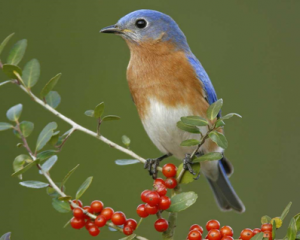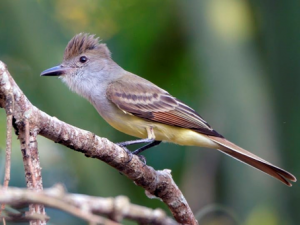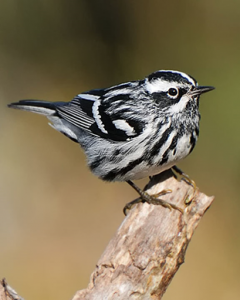Week 2 of Songbirds! How many songbirds were you able to identify last week from part 1? If you missed it last week’s Songbirds (Part 1) post, click here. This week, we will be learning more “Songbirds”. These birds can be seen in agricultural environments, hardwood swamps, hammocks, pine flatwoods, mixed forests, open woodlands, sandhills, fresh and saltwater marshes, and even in suburban areas. Grab your binoculars and go exploring with us!
Bird watching is an activity that is ageless – anyone can learn and appreciate the wonderous bird species. All you need are a pair of binoculars. Let us know if you can spot and identify one of these Songbirds this week!
Black-and-white Warbler
Habitat:
- Woods (trunks and limbs of trees)
- Winter: forests and forest edges from Florida to Colombia
Diet:
- Fairly long, slightly down curved bill
- Insects (caterpillars, flies, bugs, beetles, spiders)
Nesting:
- Placed on ground under dead leaves or limbs, against a shrub, rock, log, or tree
- Constructed in cavity at top of stump or in a depression in the ground
- Open cup (built by female) made of leaves, coarse grass stems, bark strips, pine needles, rootlets; lined with fine grass or hair
- Clutch size: 5 eggs (creamy white with brown speckles)
Click here for more information.
Tufted Titmouse

Habitat:
- Woodlands, including deciduous and evergreen forests
- Visitors at feeders and can be found in backyards, parks, and orchards
Diet:
- Stout bill
- 2/3 insects (caterpillars, wasps, bees, beetles)
- 1/3 seeds, berries, small fruit
Nesting:
- Nest site is in hole in tree, either natural cavity or old woodpecker hole; will also use nest boxes
- Foundation of grass, moss, leaves, bark strips, lined with soft materials, especially animal hair
- Bird may pluck hair from live woodchuck, dog, or other animal, even from humans
- Clutch size: 5-6 (whitish, dotted with brown, reddish, or purple)
Click here for more information.
Eastern Bluebird

Habitat:
- Meadows and openings surrounded by trees that offer suitable nest holes
Diet:
- Bill is short and straight
- Perch erect on wires, posts, and low branches in open country, scanning the ground for prey
- Flutters to ground to catch insects, often hovering to pick up items rather than landing
- Insects (crickets, grasshoppers, beetles, spiders) and berries
Nesting:
- Commonly use nest boxes as well as old woodpecker holes
- Placed in cavity, typically in natural hollow in tree, in old woodpecker hole, or in birdhouse
- Loosely constructed cup of weeds, twigs, and dry grass, lined with finer grass, sometimes with animal hair or feathers
- Clutch size: 4-5 eggs (pale blue)
Click here for more information.
Great Crested Flycatcher

Habitat:
- Woodlands, groves, open forests
Diet:
- Bill is wide at the base and straight
- “Sit-and-wait” predators
- Large insects (caterpillars, moths, butterflies, tree crickets, beetles), and fruits & berries
Nesting:
- Bulky nest made of trash (cellophane, snakeskins, string, rags)
- Hole in a tree
- Clutch size: 5-6 eggs (creamy white with brown spots)
*Note: Their clear, rising reep calls are a very common sound in summer.
Click here for more information.
Purple Gallinule

Habitat:
- Fresh swamps, marshes, ponds
- Slow-moving shallow water, lots of floating vegetation
Diet:
- Forages while walking on land, while climbing through marsh vegetation or waterside shrubs or trees, or while swimming
- Omnivorous, plant and animal matter, including seeds, fruits, leaves, insects, snails, spiders, worms, fish
Nesting:
- Nest site is in dense marsh growth, over water that is often several feet deep
- A platform of cattails, grasses, sedges, firmly anchored to standing marsh vegetation, at water level or 1-3′ above it
- Often build extra nests
- Clutch size: 6-8 eggs (buff with brown spots)
*Note: Still widespread in appropriate habitat, but undoubtedly has decreased with draining of swamps, and still vulnerable to loss of more wetlands. During migration individuals may stop over in odd habitats, even in cities.
Click here for more information.
Be sure to share with us birds that you have spotted in your yards, parks, and in your community!
 0
0

